In 2022 the tech industry continues to respond to the adjustments required to manage, support, and maintain a productive, hybrid workforce.
Several software development trends from 2021 are advancing and continue to expand rapidly, causing tech tools to evolve and change how people work. If you’re looking to make some changes in your organization or planning for changes in the future, keep an eye on these ongoing software development trends for 2022.
Low-Code/No-Code Persists
As the ongoing tech talent shortage occurs, low-code/no-code (LC/NC) applications continue to drive growth. “No-code is the future of software,” according to Katherine Kostereva, a Forbes Council member and CEO of, Creatio, a global vendor of one platform to automate industry workflows and CRM with no-code.
It’s no wonder Kostereva is optimistic with Gartner’s full-scale projection of $5.8 billion for the low-code application platform market. The low-code application platform market expects to grow by more than $73 million by 2027, according to a recent comprehensive report by Market Research Future (MRFR).
Many IT organizations and business leaders are turning an eye toward providing their staff with the ability to become “citizen developers” with LC/NC applications, thus giving their teams the power to create problem-solving applications for the company’s greater good.
In a nutshell, LC/NC applications allow non-technical staff to customize or create the tools they need with little or no coding. Think “WordPress” and content management systems (CMS) as earlier LC/NC application forms.
Some of the primary benefits of LC/NC include the ability for organizations to own their automation tools and customize them for quickly changing business needs. Embracing LC/NC allows companies to leverage hyper-automation for progress and free up A-list developers to focus on increasing speed to market for their proprietary business initiatives.
LC/NC applications have created another option for companies that streamline traditional process management tools, such as software administration, workflow, or case management systems. Other application uses include virtual assistants, chatbots, and function-specific tools for marketers.
However, LC/NC does have its drawbacks. Security concerns around LC/NC applications will require companies to ensure their workforce is up to speed on cybersecurity best practices for LC/NC development. Also, organizations will need to create frameworks for their “citizen developers” to ensure knowledge around the use of LC/NC tools becomes prolific and align with IT objectives.
AI and Machine Learning Keeps Expanding
Rapid growth continues to accelerate changes in AI even though some still consider it in the stage of infancy. By 2024 the global artificial intelligence (AI) market is expected to reach $500 billion, according to predictions from IDC.
Currently, most AI smart algorithms can focus on single performance tasks such as recognition systems or personalized recommendations. We’re moving toward the second stage of growth, where the intelligence of machines can equal humans.
Google and Microsoft lead the way in offering AutoML and no-code AI software solutions, creating a machine learning pipeline that is more transparent and simple. No-code AI software development platforms automatically create ML, and AI models apply them to real-world issues. They have a user-friendly interface, drag-and-drop features, and no need to code. Google’s TensorFlow framework is considered an excellent tool for deep learning, and artificial intelligence.
Recently Google garnered attention for its perceived human-like chatbot when a Google engineer believed the chatbot had become an eight-year-old child. Still, experts waved away the leap in advancement and said it’s not sentient.
Regardless of the sci-fi excitement, the role of AI and ML software solutions is growing as they improve processes, reduce manual work and help achieve better business results. Manufacturing, healthcare, retail, and logistics use AI and ML solutions.
Cybersecurity and Data Loss Prevention Remain a Top Need
The modernization of applications and services and the continuing workforce shift to hybrid and work from anywhere keep cybersecurity top of mind for most IT and software developer professionals.
For many enterprises to remain competitive, retain customers, and avoid incompatibilities with the latest technological advances, they need to migrate their data and processes to new platforms. For example, without the upgrade, some organizations will not be in a position to harness security trends such as DevSecOps (development, security, and operations), which embeds security throughout every stage of the DevOps process, versus at the end, where organizations could be vulnerable to cutting edge threats.
Cybersecurity technologists are particularly in demand from state, city and county governments. CIOs and CTOs working for government organizations anticipate budget increases in the coming years to increase protection from outside threats, transfer big data into the cloud, and update legacy systems.
The need to address outdated systems is the primary reason for the surprising but necessary surge in high-paying requests for developers with knowledgeable language skills in Clojure, Erlang, F#, and COBOL. These programming languages are well suited for processing large amounts of data, supporting AI, and solving complex problems across platforms to update legacy systems that will no longer operate efficiently with the latest technological advances.
For example, Clojure is well suited for processing large amounts of data related to data mining/commercial AI and large-scale predictions where parallel processing is needed. Erlang has built-in runtime support systems for distribution, concurrency, and fault tolerance required in procedures necessary for high availability and massive scalability in real-time such as instant messaging, telecom, banking, and e-commerce.
F# is an open-source, cross-platform, and interoperable universal language known for its ability to write succinct code giving developers relief from debugging and focusing on a problem domain rather than the details of programming.
Cloud Reliance on Hybrid Architectures Continues with Edge
Edge computing is evolving to save bandwidth and improve response times, safety, and customer experiences for organizations leveraging cloud services. In 2022 the IoT, AI, and machine learning are continuing to spur the growth of edge computing, enabling new applications and data models.
By the end of 2022, edge computing is expected to reach $176 billion and sustain growth through 2025 to reach $274 billion, according to the International Data Corporation (IDC) Worldwide Edge Spending Guide.
For those new to the concept, edge computing is an architecture with a topology location-sensitive form of distributed computing that brings computation and data storage closer to the data sources.
Current uses cases of edge computing cloud services include:
- Adjusting the timing of traffic signals to manage traffic
- Collecting patient data from monitors and sensors to provide patient insights
- Routing sensor data to wind substations through cell towers
Another growing trend for companies’ projects requiring scalability, security, and 24/7 availability is Kubernetes, an open-source container orchestration platform. Kubernetes is a good tool for managing containers, building a micro-services architecture, and automating the software deployment process.
Amazon, Google, Microsoft, IBM, Red Hat, Oracle, VMware, SUS, and Platform9 all offer Kubernetes-based platforms or infrastructure as a service (IaaS).
Another option exists to utilize the latest cloud technologies, serverless computing. Serverless architecture can offer more flexibility, quicker time to release, and greater scalability at a reduced cost. Developers do not need to worry about purchasing, provisioning, and managing backend servers with serverless architectures.
If you’re still wondering how the various hybrid architectures options work together, here is a valuable guide: Edge Computing the Hybrid Cloud: 3 Approaches from David Linthicum, the Chief Cloud Strategy Officer at Deloitte Consulting.
Finally, if you’d like to talk to an expert about your current technology needs, don’t hesitate to contact us. We’re happy to help.
 Download Our E-Book7 Mistakes to Avoid When Hiring DevelopersCheck out our list of seven areas where agencies and business owners might slip up when hiring a developer.Download Now
Download Our E-Book7 Mistakes to Avoid When Hiring DevelopersCheck out our list of seven areas where agencies and business owners might slip up when hiring a developer.Download Now Join Us!DrupalCon PortlandDrupal holds a special place for all of us at Esteemed, which is why we're proud to announce that we're sponsoring DrupalCon Portland.Register Now
Join Us!DrupalCon PortlandDrupal holds a special place for all of us at Esteemed, which is why we're proud to announce that we're sponsoring DrupalCon Portland.Register Now Join ColleaguesCo-working and community talent platform for digital professionals.Whether you’re a front-end developer, UX designer, project manager, or one of the many other digital professions we support, our Colleagues community is here to boost your career.Sign Up
Join ColleaguesCo-working and community talent platform for digital professionals.Whether you’re a front-end developer, UX designer, project manager, or one of the many other digital professions we support, our Colleagues community is here to boost your career.Sign Up

